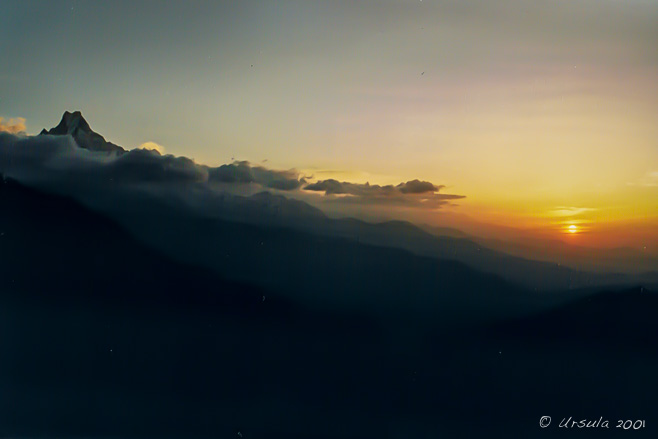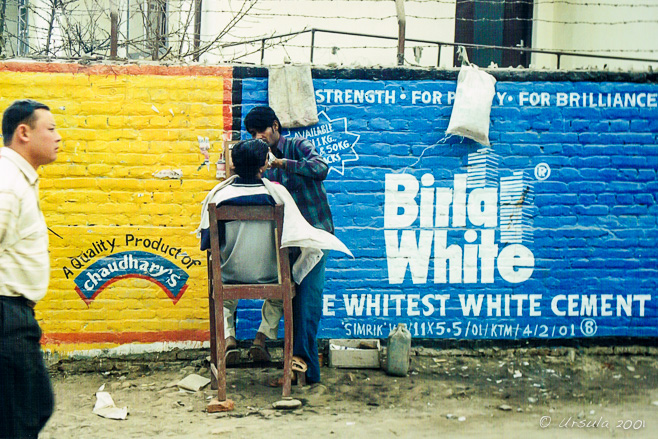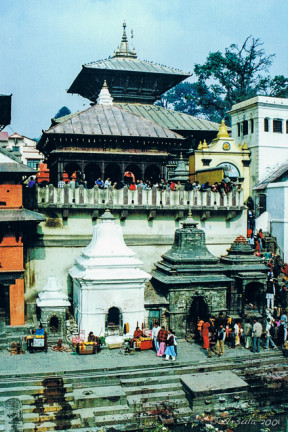
Sunrise from Deurali
Mount Machhapuchchhre (Machhapuchhre) pokes through the clouds as the sun rises over the Annapurna Range, Nepal.
I had something hot and tropical planned for this Week’s Wander – especially after last week’s foray into the cold winds of the southern Andes (Patagonia).
But, since the devastating Himalayan earthquake on April 25th, I cannot get Nepal out of my mind. Clearly, judging from my Facebook feed, I am not alone. In true six- (or fewer-) degrees of separation, everyone I know has some connection with the country.
Nepal was my first experience of “the other”; the truly foreign – my first taste of the developing world. A world where they burn bodies openly on the river in the daytime and burn garbage in the streets at night; a land where, even in 2001, there was almost no phone service outside the cities; a country with unremitting noise and smells, and the worst toilets imaginable.
And I loved it.
From the dusty, noisy chaos that is Kathmandu, through the lowland lakes and jungles, to the magnificent soaring peaks that are the Himalaya(s), I loved it all.
I spent five weeks trekking and travelling in Nepal back in 2001, and I was itching to go back as soon as I left. But then the royal family was murdered, opening the way for an increase in the civil unrest that was already brewing while I was there, and the country became markedly less safe for many years.
When I arrived in February of 2001, descending through the low-lying clouds and the haze of pollution and dust into Kathmandu, the airport was little more than a glorified tin shed. Even with upgrades, it is currently struggling to cope with the flood of increased traffic attempting to help the relief effort. I was carrying a brand-new SLR film camera that I had no idea how to use: being really technically-minded about these things, I had bought a Canon over a Nikon in the same price range because it was lighter. In my defence, when you are carrying packs up and down mountain paths in the Himalaya, weight matters. Looking at the photos now, I can see how much my “photographic eye” has changed over the years, and I realise my cheap scanner is not up to photographic quality.
Still, this post is more about the memories – souvenirs in French – than it is about the photographs themselves.
Please join me on a trip down memory lane. to a beautiful country where the people have always struggled, and are, today, struggling more than ever.

Street Shave
Kathmandu was my first experience outside the “developed” world. Fortunately for me, it was winter, so it was not too hot – keeping the assault of smell at bay. The rickety bus to the hotel provided a welcome buffer against the culture shock of the rubble, the dust, the skinny dogs and kids, the odd cow, the garbage and the throngs of people with something to sell… Motorcycles, ancient buses and tuk tuks crowded everywhere. Car horns pipped constantly – day and night.
Of course, after years of living and working in Asia, I’m an old hand at all of this, and navigate it easily. But, you always remember your first.

Cremation Ghats
Tourists were not allowed on the ghats themselves, …

Bagmati River
… so we stayed at a respectful distance across the river.

Cremation Ghats ~ Bagmati River
The ghats were relatively quiet, and only a few funeral pyres were burning when I was there in 2001; at the moment, they cannot keep up with the earthquake casualties, and are running out of the wood it takes to consume a body.

Sakyapa Gompa, Bodhnath
Buddhist and Hindu temples rub shoulders in the Kathmandu Valley. I don’t know about this particular temple, but many districts have been completely flattened by the quake. For a photographer’s view on the ground, check out the recent posts by Gavin Gough who is in Nepal at the invitation of an NGO: “Nepal Earthquake”

Colourful Truck
I spent most of the drive from Kathmandu to the starting point of our Annapurna trek with my nose pressed to the window: I’d never before seen sadhus travelling on roadsides and traffic that seems to have no regard for rhyme or rules.
The parlous state of the roads – even before the earthquake and aftershocks tore through them – is making distribution of relief even more difficult.

Trail Head at Naya Phul (Nayapul)
This is where the fun starts! Off the bus we trundled. We walked across the Modi River; through the gauntlet of shops selling scarves (necessary against breathing too much dust), water bottles and trinkets; and into the Annapurna Conservation Area.

Our Sherpa Guides: Dendi, Dipak, Ongchhu and Purna
These were our Sherpas. In addition, our small group of seven trekkers had four porters who carried the overnight bags, and brought us our morning wash-water (no showers) and hot tea (no coffee!), etc. The Australian company (Peregrine) I travelled with ensures that porters are properly paid, not overly burdened, and have decent footwear. In a country as poor as Nepal, these minimal conditions are often not met. Sherpa guides called a strike in 2014 over conditions and compensation after the deadly avalanche on Mount Everest.

Kids Begging
Children hang around trekkers, looking beseeching and adorable. They have got into the habit of begging for sweets and pens. We gave donations to the local schools instead of caving into them.

Girl at the Well
Once we entered the mountains, we had very little running water and no electricity. For me, it was only days at a time; for the locals, this is a way of life. Of course, with the earthquake, access to clean water has become much more difficult – even in the city.

Goat Herder
“Childhood” is a relative construct. In countries like Nepal, children start work at a young age.

Up through Rocky Terraces
One thing Nepal has lots of: rock. No shortage. The country actually exports gravel and crushed stone.

Hiunchuli
Our first glimpse of the heavens: Hiunchuli, a 6641 metre peak in the southern part the Annapurna mountain range rises up in front of us.

Terraced Fields
Below us, the terraced farms drop back down to the river: from what we saw, it was mostly cabbage and potato at these altitudes.

Annapurna Daybreak
Every morning we were woken up to a bowl of reasonably warm water for washing, and a cup of tea. Then, we’d eat breakfast (porridge, two eggs, and either Nepalese bread, toast or chapattis) surrounded by snow-covered peaks.

Gurung Woman
The Gurung or Tamu people are one of the many ethnic groups in this region. The famous Gurkha soldiers within the British Army are recruited from these strong, proud people.

“A little Bit Up”
Every day our guide would tell us the next day would involve “a little bit up, a little bit down.” We decided that “A little bit up” was Nepalese for “Bring an ice-pick”. Those hills seemed to go up forever!

Rhododendrons
The famous rhododendron trees of Nepal flower from late February through April.

Machhapuchchhre
Also spelled “Machhapuchhre”, or “Fish Tail” in English, Machhapuchchhre rises up from the forests and into the clouds.

Cornbread for Lunch
“Rustic” is a word that comes to mind; I was not used to people squatting to perform daily tasks, and the concept of food preparation on the the floor of the kitchen was completely foreign to me.

Tadapani (2700 m)
Crude buildings cling precariously to cliffs – always in sight of those magnificent mountain peaks. One of the things that struck me, however, was the noise: as soon as the sun cracked over the horizon, people would be chattering as they went about their work, and the dogs would set off barking as the cocks crowed.

Ghorepani (2874m)
Poon Hill (3210 m) marked the high point of our trek. When we learned it was all back down hill from this point, one of our group broke into a rendition of “The Hills are Alive”. We descended shale steps into Ghore (horse) Pani (water), where traders have long watered their ponies. I remember it as the place I was able to book a short, crackly overseas phone call, at $US200, to touch base with family after several days off the grid.

Sorting Rice – Banthanti (2250m)
Every small task is time consuming. Still, people have the time to smile and chat. I sent this young woman back a copy of the photos I took of her.

Loaded Porter
In many places, the only way to get goods in or out is to carry them. We even saw porters carrying lengths of timber for building.

Ulleri (2070m)
We got used to “basic” accommodation pretty quickly: mud huts, wooden structures perched on the sides of cliffs, tin roofs held down with stones. The “lodges” we stayed in didn’t quite conform to any building code I’m aware of: two foam mattresses on wooden frames in a tiny cubbyhole with drafts that blew out the candles – no electricity, remember. We learned to keep a torch handy for the cold walk to the outhouse in the night. There was no such thing as soundproofing: “Goodnight, John-boy” became a running joke; snores and “Oh yuch, who was that?!” could be heard from the rooms four doors down. At some lodges we could even see each other through the cracks in the walls.

Laundry – Tirkedunga (1525m)
Laundry and dishes are all done manually at the town taps; shampoos and showers are also conducted (modestly) in the same place.

Purna and Friend
While the scenery is magnificent, …

Young Man, Birethanti 1065m
… it’s the people that make a trip.

Modi Khola
A long part of the walk back to Naya Phun is along the beautiful Modi Khola …

Naya Phul Terraces
… to the rice terraces in the river valley.
Nepal has always been a a poor country: as a backpacker haven, it hasn’t managed to put the same kind of price-tag on its priceless mountains as its near-neighbour Bhutan, and doesn’t have the resources or infrastructure to manage the current disaster.

My husband and I have had a long relationship with the Himalayan Foundation and supported a child in the Kathmandu Valley through World Vision for many years until they re-focussed elsewhere. I know some of the good people at UNICEF; any of these organisations, or the Red Cross, Oxfam, or other reputable aide groups would be happy to accept any help you can give them.
As would the beautiful, proud people of Nepal.
Let’s help where we can.
Pictures scanned from print photos taken February2001.


































.jpg)


[…] It was day four of a short trek under the patient and watchful eye of our guide Angfula Sherpa, and I was finally hitting my stride. My husband and I were part of a small group walking the Ghorepani/Poon Hill circuit in the Annapurna Conservation Area of the Himalaya. The walking we had done the three days prior (more abut that anon) had been tough: the constant rocky uphill climbs had taken their toll on my aging knees and hips and my gasping lungs, and had left me wishing sincerely that I had trained better in preparation for what was feeling more like an ordeal than a holiday. I was so much older and less fit than the last time I walked these trails (Heaven and Hard Work). […]
[…] first time I visited Pashupatinath, some 15+ years ago (see: Heaven and Hard Work), I was almost overwhelmed by the experience: I found the sight of families around the […]